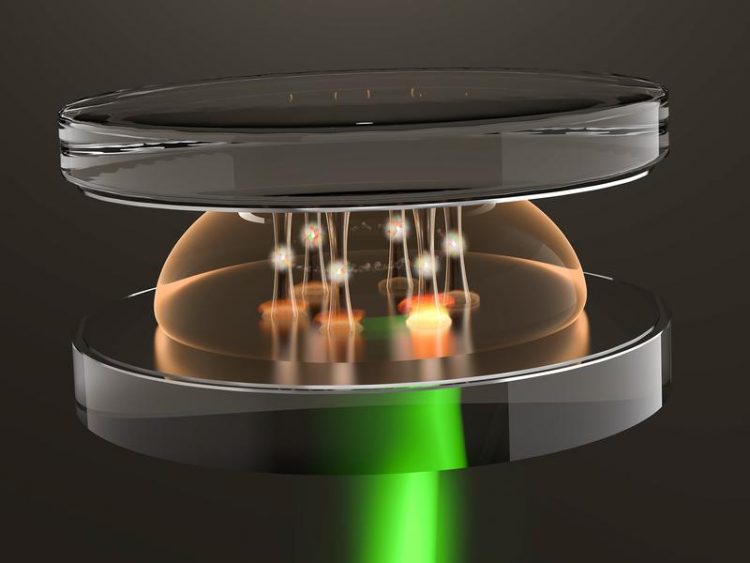Exotic quantum states made from light: Physicists create optical “wells” for a super-photon

Potential wells The artist's rendering shows how potential wells are created for the light in the microresonator through heating with an external laser beam (green). © Photo: David Dung/Uni Bonn
Light particles (photons) occur as tiny, indivisible portions. Many thousands of these light portions can be merged to form a single super-photon if they are sufficiently concentrated and cooled.
The individual particles merge with each other, making them indistinguishable. Researchers call this a photonic Bose-Einstein condensate. It has long been known that normal atoms form such condensates.
Prof. Martin Weitz from the Institute of Applied Physics at the University of Bonn attracted attention among experts in 2010 when he produced a Bose-Einstein condensate from photons for the first time.
In his latest study, Prof. Weitz’ team experimented with this kind of super-photon. In the experimental setup, a laser beam was rapidly bounced back and forth between two mirrors. In between was a pigment that cooled the laser light to such an extent that a super-photon was created from the individual light portions. “The special thing is that we have built a kind of optical well in various forms, into which the Bose-Einstein condensate was able to flow,” reports Weitz.
A polymer varies the light path
The team of researchers used a trick here: It mixed a polymer into the pigment between the mirrors, which changed its refractive index depending on the temperature. The route between the mirrors for the light thus changed so that longer light wavelengths passed between the mirrors when heated. The extent of the light path between the mirrors could be varied, in that the polymer could be warmed via a very thin heating layer.
“With the help of various temperature patterns, we were able to create different optical dents,” explains Weitz. The geometry of the mirror only appeared to warp, while the refractive index of the polymer changed at certain points – however, this had the same effect as a hollow shape. Part of the super-photon flowed into this apparent well. In this way, the researchers were able to use their apparatus to create different, very low-loss patterns that captured the photonic Bose-Einstein condensate.
Precursor of quantum circuits
The team of researchers investigated in detail the formation of two neighboring wells, controlled via the temperature pattern of the polymer. When the light in both optical hollows remained at a similar energy level, the super-photon flowed from one well into the neighboring one. “This was a precursor of optical quantum circuits,” highlighted the physicist at the University of Bonn. “Perhaps even complex arrangements, for which quantum entanglement occurs in interaction with a possible photon interaction in suitable materials, can be produced with this experimental setup.”
This would, in turn, be the prerequisite for a new technique for quantum communication and quantum computers. “But that’s still a long way off,” says Weitz. The findings by the research team could also conceivably be used to further develop lasers – for instance for highly precise welding work.
Publication: David Dung, Christian Kurtscheid, Tobias Damm, Julian Schmitt, Frank Vewinger, Martin Weitz & Jan Klärs: Variable Potentials for Thermalized Light and Coupled Condensates, Nature Photonics, DOI: 10.1038/nphoton.2017.139
Media contact:
David Dung M.Sc.
Institute of Applied Physics
University of Bonn
Tel. +49 (0)228/733453 or 733455
E-mail: dung@iap.uni-bonn.de
Prof. Martin Weitz (available from 21 Aug 2017)
Institute of Applied Physics
University of Bonn
Tel. +49 (0)228/734837 or 734836
E-mail: weitz@uni-bonn.de
Media Contact
More Information:
http://www.uni-bonn.de/All latest news from the category: Physics and Astronomy
This area deals with the fundamental laws and building blocks of nature and how they interact, the properties and the behavior of matter, and research into space and time and their structures.
innovations-report provides in-depth reports and articles on subjects such as astrophysics, laser technologies, nuclear, quantum, particle and solid-state physics, nanotechnologies, planetary research and findings (Mars, Venus) and developments related to the Hubble Telescope.
Newest articles

A universal framework for spatial biology
SpatialData is a freely accessible tool to unify and integrate data from different omics technologies accounting for spatial information, which can provide holistic insights into health and disease. Biological processes…

How complex biological processes arise
A $20 million grant from the U.S. National Science Foundation (NSF) will support the establishment and operation of the National Synthesis Center for Emergence in the Molecular and Cellular Sciences (NCEMS) at…

Airborne single-photon lidar system achieves high-resolution 3D imaging
Compact, low-power system opens doors for photon-efficient drone and satellite-based environmental monitoring and mapping. Researchers have developed a compact and lightweight single-photon airborne lidar system that can acquire high-resolution 3D…





















